
Swampoodle was a neighborhood in Washington, D.C. on the border of Northwest and Northeast in the second half of 19th and early 20th century. This neighborhood is no longer known as Swampoodle and has been replaced in large part by NoMa.

C. W. & George L. Rapp, commonly known as Rapp & Rapp, was an American architectural firm famed for the design of movie palaces and other theatres. Active from 1906 to 1965 and based in Chicago, the office designed over 400 theatres, including the Chicago Theatre (1921), Bismarck Hotel and Theatre (1926) and Oriental Theater (1926) in Chicago, the Five Flags Center (1910) in Dubuque, Iowa and the Paramount Theatres in New York City (1926) and Aurora, Illinois (1931).
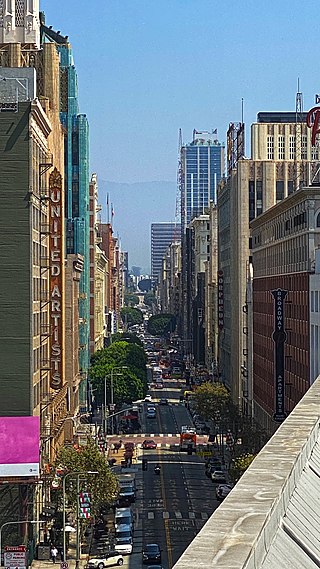
Broadway, until 1890 Fort Street, is a thoroughfare in Los Angeles County, California, United States. The portion of Broadway from 3rd to 9th streets, in the Historic Core of Downtown Los Angeles, was the city's main commercial street from the 1910s until World War II, and is the location of the Broadway Theater and Commercial District, the first and largest historic theater district listed on the National Register of Historic Places (NRHP). With twelve movie palaces located along a six-block stretch of Broadway, it is the only large concentration of movie palaces left in the United States.
The Blue Mouse Theatre title was used for several historic vaudeville and movie venues opened by John Hamrick in the Pacific Northwest of the United States. The name may have been inspired by a lounge in Paris. Hamrick is said to have used the colored rodential title for his first theatre in each city.

H Street is a set of east–west streets in several of the quadrants of Washington, D.C. It is also used as an alternate name for the Near Northeast neighborhood, as H Street NW/NE is the neighborhood's main commercial strip.
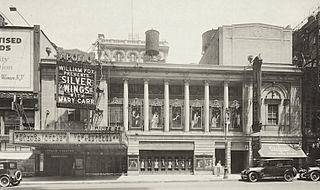
The Times Square Theater is a former Broadway and movie theater at 215–217 West 42nd Street in the Theater District of Midtown Manhattan in New York City, near Times Square. Built in 1920, it was designed by Eugene De Rosa and developed by brothers Edgar and Archibald Selwyn. The building, which is no longer an active theater, is owned by the city and state governments of New York and leased to New 42nd Street.

Near Northeast, also known as Néné, is a neighborhood in Northeast Washington, D.C. It is bounded by North Capitol Street to the west, Florida Avenue to the north, F Street to the south, and 15th Street to the east.
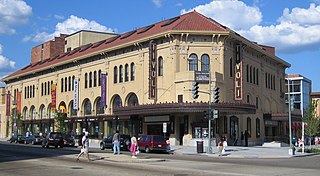
The Tivoli Theatre is a landmark building in the Columbia Heights neighborhood of Washington, D.C., on 14th Street and Park Road Northwest. Originally built as a movie theater, it currently exhibits live stage productions as the home of the GALA Hispanic Theatre.
Apollo Theatre or Apollo Theater may refer to:

The H Street Playhouse was a black box theater and gallery located in the Atlas District of Washington, D.C. Home to resident companies Scena Theatre, Theater Alliance and Forum Theatre, the Playhouse also hosted African Continuum Theatre Company, Musefire, Landless Theater Company, Theater Blue, Journeymen Theater Company, Madcap Players, Solas Nua, Restoration Stage, Capitol Renaissance Theatre, and Barnstormers. After opening its doors in 2001, the H Street Playhouse, with Theater Alliance, was at the forefront of a movement to develop and revitalize the H Street commercial corridor. The H Street Playhouse closed in 2012.
John Hamrick (1875–1956) was an American entrepreneur in the theater business. He leased and owned a large number of vaudeville and movie theaters in the Northwest from at least the early 1920s until the late 1940s. Hamrick lived in Seattle, Washington and eventually assembled a string of theaters that included the Rex Theatre, which he was in charge of as early as 1913. the Oriental Theatre in Portland, Oregon, the Beverly, several Blue Mouse Theatres, the Music Box Theatre, the Riviera Theatre, and the Roxy Theatre. Hamrick also owned several theaters in Seattle and is generally credited as being the first Seattle theater owner to show "talking pictures."

The Oriental Theatre was a movie theater located at 828 SE Grand Street in the East Portland commercial district of Portland, Oregon that was built in 1927. The Oriental was a 2,038-seat movie palace designed by Lee Arden Thomas and Albert Mercier. The building's exterior was in the Italian Renaissance style. The interior had an "almost surreal appearance" created by interior designer Adrien Voisin. It was built by George Warren Weatherly. Demolished in 1970, the theater was adjacent to the Weatherly Building, which remains standing.

The Orpheum Theater opened in Champaign, Illinois in 1914 on the site of a vaudeville theater built in 1904. Designed by the Architectural firm Rapp & Rapp, the Orpheum was built to accommodate both live vaudeville performances and the projection of film. After a series of renovations and changes of ownership, the Orpheum screened its final film in 1986.
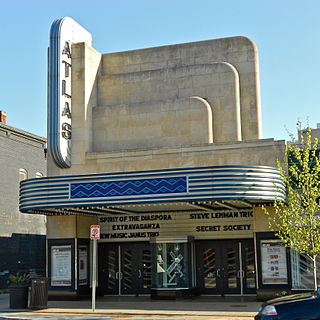
The Atlas Performing Arts Center is a multiple space performing arts facility located on H Street in the Near Northeast neighborhood of Washington, DC. Housed in a renovated Art Deco movie house, the facility is home to several arts organizations.

The Apollo Theatre was a Broadway theatre whose entrance was located at 223 West 42nd Street in Manhattan, New York City, while the theatre proper was on 43rd Street. It was demolished in 1996 and provided part of the site for the new Ford Center for the Performing Arts, now known as the Lyric Theatre.
Reginald Wycliffe Geare was an American architect known for his design of theaters. His career was ended by the Knickerbocker Theatre disaster, when a record snowfall collapsed the theater's flat roof, killing 98.

Harry Milton Crandall (1879–1937) was an American businessman who owned a chain of 18 theaters in Washington D.C., Maryland, Virginia, and West Virginia. Among the theaters he owned was the Savoy, in Washington, D.C., his fourth acquisition.
The Moon Theater was a silent movie theater at 1410 Douglas Street in Downtown Omaha, Nebraska. The 1,600-seat theater was built on the site of Omaha's first movie theater, the Parlor. In later years the theater was renamed the Town Theater and eventually the Cooper Theater. The building was demolished in 1976.
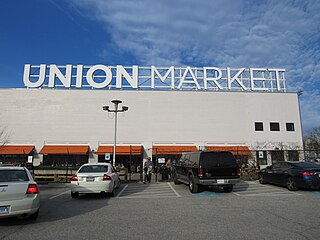
Union Market is a food hall located in Washington, D.C. It anchors the Union Market District, a neighborhood encompassing high-rise apartments, office buildings, retail, and entertainment options.

The Anco Cinema was a former Broadway theatre turned cinema at 254 West 42nd Street, between 7th and 8th Avenues in Manhattan, New York City. It opened in 1904 and was originally named the Lew Fields Theatre. It continued to operate as a playhouse under various names until it was converted into a movie theatre in 1930. Its block was famous for its concentration of Broadway theatres turned cinemas. After World War II, the street declined and the Anco Cinema eventually became a pornography venue. It closed as a cinema in 1988 and was gutted for retail use. The building was demolished in 1997.















